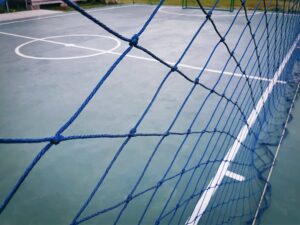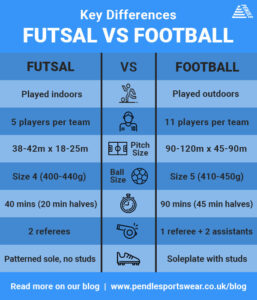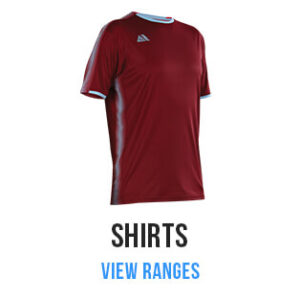Last Updated on: 30th October 2023, 10:48 am
Futsal vs Football – What’s the Difference?
How are Futsal and Football Different?
At first glance, football and futsal (pronounced fut·sl) may appear strikingly similar. After all, both involve a ball and goals, with the aim of getting the ball into the net. However, as you delve deeper into these sports, you begin to unravel the distinctions in rules, setup, and the rhythm of play that sets them apart. In this blog post, we’ll explore the shared traits and unique characteristics of both sports, while also finding answers to some frequently asked questions about futsal. Let’s kick things off by taking a closer look at the similarities between the sports.
Shared Traits
Field Markings
Both sports have rectangular pitches, marked with lines (touchline, goal lines and halfway lines), centre circles, corner arcs and penalty spots.
Scoring
In both games, the focal point is the ball, and a goal is scored when the ball is passed over the goal line between the goalposts. To win the game, one team must outscore their opponents by the end of the match.
Fouls
Both football games have booking points assigned to red and yellow cards. These act as sanctions and accumulate over the course of the game. The list of fouls committed that result in direct free kicks or penalty kicks is the same for both sports.
Competitions
Like football, the Futsal World Cup is held every 4 years and invites teams from all over the world to compete. Both sports have also been in the Olympics, with futsal making its debut in the 2018 Summer Youth Olympics.
Understanding the Differences
Playing Surface
The pitch
Traditionally, futsal is played indoors on a flat and smooth hardcourt, resembling a basketball court. For football, turf is the normal playing surface whether natural, hybrid or artificial grass.
Pitch Size
Futsal pitches vary in length from 38-42m and in width from 18-25m. Football pitches are much larger, measuring 90-120m in length and 45-90m in width.
When compared to the dimensions of a 5-a-side football pitch, a futsal pitch is longer and thinner. This makes attacking with a ball more difficult and demands fast-paced footwork. For more information, read the FA’s handy futsal pitch size guide.
Penalty area
Futsal pitches don’t have the same distinctive rectangular penalty areas that football pitches do. Instead, the penalty areas are semi-circles. Also, the penalty spot is positioned 11 meters from the goal line, as opposed to 6 meters from the goal line on football pitches.
Members Involved
Team Size
While football games usually have 11 players per team, futsal teams have 5 players on the field at a time, including a goalkeeper.
Referees
Futsal matches typically have two referees officiating a game, which allows for better coverage of the small playing area and quicker decision-making. Similar responsibilities are held by them and they are expected to manage the tempo and fairness of the game. Football matches at most levels feature one referee assisted by two assistant referees.
Kits and Equipment
Ball Size
A size 4 ball (400-440g) is typically used for a futsal game in comparison to a size 5 ball (410-450g) for football games. Futsal balls are typically smaller and have 30% less bounce than a traditional football. This allows players to have more control over the ball which is important when attacking is more difficult.
Kits
Wearing gloves is standard for football goalkeepers but most futsal goalkeepers don’t wear gloves. Wearing gloves is uncommon because the ball is much smaller. It is much easier to grip and catch the ball without gloves.
Unlike football boots, which typically have studs for grass or turf surfaces, futsal shoes lack these since it is played indoors. Their soles are generally made of non-marking gum rubber with a patterned sole to provide grip on smooth surfaces. The shoes also tend to be more lightweight than football shoes for precise ball control and touch.
Timings
Game Duration
Futsal matches are split into two 20-minute halves, with a 15-minute break for half-time. This is under half the length of a football match, which is split into two 45-minute halves and lasts 90 minutes in total, plus a 15-minute break.
Stoppages
The clock stops in futsal games whenever the ball goes out of play and will only start again when play resumes. However, in football games, the clock continues running and stoppage time is added by referees at the end of each half. This accommodates for time lost due to injuries, substitutions and red/yellow cards being issued. Stoppage time is also known as added or injury time.
Frequently Asked Questions
What does futsal mean?
The term is derived from the Spanish or Portuguese words “fútbol” (football) and “sala,” meaning room or indoor.
When was it invented?
Futsal was invented in Montevideo, Uruguay in the 1903s by schoolteacher Juan Carlos Ceriani.
Where is futsal played?
It is played in hardcourt indoor sports facilities all over the world. The courts are similar to basketball courts with their smooth, hard surface.
When is futsal season?
The sport is typically played year-round and isn’t tied to a specific season like outdoor football.
Can futsal be played outdoors?
While primarily an indoor sport, variations of futsal can be played outdoors, but they may not adhere to the same strict rules.
Is futsal harder than football?
The decision of which is harder than the other is subjective. Since football pitches are larger than futsal pitches, football players do more running. However, a futsal pitch is smaller, so players interact with the ball more which demands a higher intensity level throughout the game.
Why do people play futsal instead of football?
People play futsal for various reasons, including skill development, year-round play, a social experience, intense cardiovascular workouts, and accessibility to indoor facilities.
Can futsal players play football?
Yes, many players can transition to football since the skills they have developed such as ball control and quick decision-making, can be beneficial in football.
More Information
If you want to read more about futsal, its benefits and how you can get involved, click the links below to read more information.
Check out our kits suitable for futsal players below.





